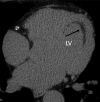Fatty foci within the heart diagnosed with ECG-gated multi-slice computed tomography: frequency and morphology
- PMID: 24846568
- PMCID: PMC4043540
- DOI: 10.12659/MSM.890271
Fatty foci within the heart diagnosed with ECG-gated multi-slice computed tomography: frequency and morphology
Abstract
Background: The purpose of our study was to analyze the frequency of focal fatty replacement (FR) of the heart, as well as the distribution and detailed morphology of FR in a large group of patients referred to multi-slice computed tomography with ECG-gating examinations (ECG-MSCT) for various clinical reasons.
Material and methods: The ECG-MSCT examinations of 1830 consecutive patients were analyzed. The examinations were performed using 8-row (1015 patients) and 64-row (815 patients) MSCT, in pre- and post-contrast scanning. We analyzed the morphology of FR, the dimensions and densities of changes, as well as the morphology and localization of FR with regard to clinical diagnosis.
Results: 204 subjects (11.1%) had FR within the heart (113 men; 91 women; mean age 57.8 years); 66% of fatty foci were seen only in the native scanning. The distribution of the fat was: right ventricle (RV) 31.9%, left ventricle (LV) 21.5%, biventricular 39.7%, interventricular or atrial septum 5.9%, and atria 1%. In the RV, fat was localized mainly in the papillary muscles, while in the LV fat was mainly subendocardial (p<0.001). The morphology of the fat was: linear 61.6%, oval 14.8%, punctuate 10.6%, irregular 10.2%, and bilobular 2.8%. Fat was primarily located subendocardially in the LV in patients after myocardial infarction. In patients with suspected coronary artery disease, it was mainly observed subpericardially in the RV and in papillary muscles (p<0.001).
Conclusions: The incidental frequency of FR within the heart in patients diagnosed with the ECG-MSCT examinations is about 11%. Pre-contrast scanning is the most valuable for FR assessment.
Figures




Similar articles
-
Fatty foci within the heart and the accompanying changes in the coronary arteries diagnosed in electrocardiogram-gated multislice computed tomography of the heart.Folia Morphol (Warsz). 2014 Nov;73(4):455-61. doi: 10.5603/FM.2014.0068. Folia Morphol (Warsz). 2014. PMID: 25448903
-
Lipomatous hypertrophy of the interatrial septum in ECG-gated multislice computed tomography of the heart.Med Sci Monit. 2012 Jul;18(7):MT54-9. doi: 10.12659/msm.883197. Med Sci Monit. 2012. PMID: 22739745 Free PMC article.
-
The applications of non-ECG-gated MSCT angiography in children with congenital heart disease.Int J Cardiol. 2012 May 3;156(3):309-14. doi: 10.1016/j.ijcard.2010.11.009. Epub 2010 Dec 15. Int J Cardiol. 2012. PMID: 21163542
-
New acquisition method to exclusively enhance the left side of the heart by a small amount of contrast material achieved by multislice computed tomography with 64 data acquisition system.Int J Cardiol. 2007 Jan 8;114(2):265-9. doi: 10.1016/j.ijcard.2005.11.066. Epub 2006 Mar 6. Int J Cardiol. 2007. PMID: 16624431
-
Right ventricular fat infiltration in asymptomatic subjects: observations from ECG-gated 16-slice multidetector CT.J Comput Assist Tomogr. 2007 Jan-Feb;31(1):22-8. doi: 10.1097/01.rct.0000236416.05267.6c. J Comput Assist Tomogr. 2007. PMID: 17259829
Cited by
-
Fatty Images of the Heart: Spectrum of Normal and Pathological Findings by Computed Tomography and Cardiac Magnetic Resonance Imaging.Biomed Res Int. 2018 Jan 9;2018:5610347. doi: 10.1155/2018/5610347. eCollection 2018. Biomed Res Int. 2018. PMID: 29503824 Free PMC article. Review.
-
Society for Cardiovascular Magnetic Resonance 2020 Case of the Week series.J Cardiovasc Magn Reson. 2021 Oct 11;23(1):108. doi: 10.1186/s12968-021-00799-0. J Cardiovasc Magn Reson. 2021. PMID: 34629101 Free PMC article. Review.
References
-
- Kiès P, Bootsma M, Bax J, et al. Arrhythmogenic right ventricular dysplasia/cardiomyopathy: screening, diagnosis, and treatment. Heart Rhythm. 2006;3:225–34. - PubMed
-
- McKenna WJ, Thiene G, Nava A, et al. Diagnosis of arrhythmogenic riht ventricular dysplasia/cardiomyopathy. Task Force of the Working Group Myocardial and Pericardial Disease of the European Society of Cardiology and of the Scientific Council an Cardiomyopathies of the International Society and Federation of Cardiology. Br Heart J. 1994;71:215–18. - PMC - PubMed
-
- Baroldi G, Silver MD, De Maria R, et al. Lipomatous metaplasia in left ventricular scar. Can J Cardiol. 1997;13:65–71. - PubMed
-
- Beltrami AP, Urbanek K, Kajstura J, et al. Evidence that human cardiac myocytes divide after myocardial infarction. N Engl J Med. 2001;344:1750–57. - PubMed
-
- Basso C, Barbazza R, Thiene G. Lipomatous hypertrophy of the atrial septum. Circulation. 1998;97:1423. - PubMed
MeSH terms
Substances
LinkOut - more resources
Full Text Sources
Other Literature Sources

